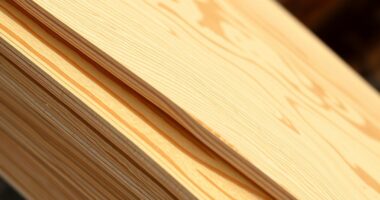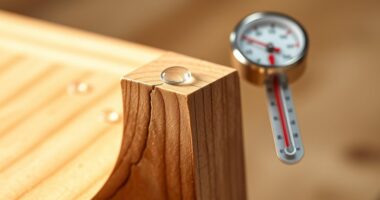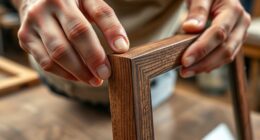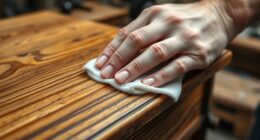Spalted wood can hide toxic mold and fungal spores that may cause allergic reactions or respiratory issues if you don’t handle it properly. Always wear a respirator, gloves, and eye protection, and work in well-ventilated spaces or outdoors. Inspect the wood carefully for mold signs before starting and treat contaminated pieces with mold-killing solutions. Proper storage and tool cleaning help prevent new growth. Follow these safe practices to protect yourself—there’s more you should know.
Key Takeaways
- Always wear a high-quality respirator, gloves, and eye protection when handling spalted wood to prevent mold spore inhalation and contact.
- Work outdoors or in well-ventilated areas to minimize airborne spores and reduce respiratory health risks.
- Inspect wood carefully for mold, fuzzy growth, or musty odors before starting projects; discard or treat contaminated pieces.
- Use mold-killing solutions on suspect wood, but remember that sealing doesn’t eliminate spores embedded deep inside porous material.
- Store spalted wood in dry, ventilated spaces and clean tools thoroughly after handling to prevent mold spread and contamination.

Spalted wood, prized for its unique coloration and striking patterns, can hide serious health risks that many crafters overlook. Beneath its beautiful surface, spalted wood often harbors toxic mold and fungal spores, which pose significant health hazards if not properly managed. These fungi thrive in the moist, decayed areas where spalting occurs, increasing the risk of inhaling airborne spores during cutting or sanding. When disturbed, fungal spores can become airborne and easily enter your respiratory system, potentially causing allergic reactions, respiratory irritation, or more severe health issues over time. Recognizing these risks is essential to guarantee your safety while working with spalted wood.
Before you start working, always assume that spalted wood may contain mold and spores, especially if it’s been stored in a humid environment. Wearing protective gear is non-negotiable. Use a high-quality respirator mask rated for mold protection to avoid inhaling spores, and always work in a well-ventilated area or outdoors when possible. Eye protection and gloves are also necessary to prevent spores from contacting your skin or eyes. Handling the wood carefully minimizes the disturbance of spores and reduces the risk of airborne contamination. Additionally, understanding mold contamination and its impact on health can help you take more effective precautions.
Always wear protective gear and work outdoors when handling spalted wood to prevent mold exposure.
It’s also indispensable to inspect your wood thoroughly before beginning any project. Look for fuzzy or powdery growths, discoloration, or an unusual musty smell—these are signs of mold contamination. If you suspect mold growth, it’s best to avoid using that piece altogether or to treat it with specialized mold-killing solutions designed for wood. Remember, simply sanding or sealing the surface won’t eliminate the spores embedded deep within the wood; spores can reside in the porous structure long after visible mold has been removed.
Proper storage of spalted wood is equally important. Keep it in a dry, well-ventilated area away from excessive humidity to inhibit mold growth. If you notice new growth or increased mold presence, take immediate steps to treat or dispose of the wood safely. When working with spalted wood, clean all tools and work surfaces thoroughly afterward to prevent cross-contamination and to protect yourself during future projects.
Frequently Asked Questions
Can Spalted Wood Be Safely Used for Food-Contact Items?
You shouldn’t use spalted wood for food-contact items because of food safety concerns. Spalted wood can harbor toxic spores and fungi that pose health risks if ingested. Even if it looks safe, these spores can be invisible and harmful. To protect yourself and others, avoid using spalted wood in any applications where it touches food, and always opt for non-toxic, food-grade materials instead.
Are There Specific Tools Recommended for Working With Spalted Wood?
Imagine working with spalted wood like handling fragile glass—you need the right tools. For safe cutting, use specialized blades designed to handle its unique texture and prevent splinters. Always wear protective gear like masks and gloves to guard against spores and dust. These tools and precautions help you avoid hazards, ensuring your project is safe and successful. Proper tools make all the difference when working with challenging materials like spalted wood.
How Can I Identify the Presence of Dangerous Fungi in Spalted Wood?
To identify dangerous fungi in spalted wood, you should focus on fungal identification by examining the color, texture, and smell of the wood. Look for unusual discolorations, fuzzy growths, or mold, which can indicate harmful fungi. Always follow safety precautions, such as wearing gloves and masks, to avoid inhaling spores. If you’re unsure, consult a mycologist or expert to guarantee safe handling and working practices.
Is There a Safe Way to Remove Mold or Spores From Spalted Wood?
You can safely remove mold or spores from spalted wood by performing mold remediation carefully. Wear protective gear like masks, gloves, and goggles to prevent spores from contacting your skin or inhaling them. Use a vacuum with a HEPA filter for spores removal, and clean the surface with a fungicidal solution. Always work in a well-ventilated area, and dispose of contaminated materials properly to reduce health risks.
What Are the Long-Term Health Risks of Handling Spalted Wood Regularly?
Handling spalted wood regularly is like walking through a minefield—you might not see the danger, but fungal toxins pose real risks. Long-term exposure can lead to respiratory hazards, chronic coughing, or allergic reactions. Over time, your immune system could weaken. To stay safe, always wear protective gear, guarantee proper ventilation, and limit your exposure. Being cautious today keeps health hazards at bay tomorrow.
Conclusion
Remember, an ounce of prevention is worth a pound of cure. When working with spalted wood, always wear proper protective gear and make sure good ventilation. Don’t underestimate the hidden dangers lurking in this beautiful material—safety should always come first. By staying cautious and informed, you can enjoy crafting with spalted wood without risking your health. After all, it’s better to be safe than sorry, especially when dealing with nature’s unpredictable surprises.









